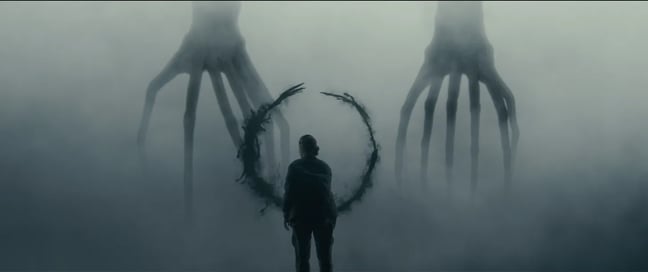Whispers of the Unknown: Exploring the Visual Brilliance, Emotional Depth, and Timeless Morality of Arrival
Cinemapedia
When Denis Villeneuve’s Arrival premiered in 2016, it wasn’t just another science fiction film about aliens—it was a profound meditation on time, language, and humanity’s capacity to connect. Starring Amy Adams in one of her most powerful performances, Arrival redefined the genre by combining stunning visuals, a gripping narrative, an evocative score, and a deeply moving moral message. This film doesn’t just tell a story—it invites the audience to think, feel, and reflect on what it means to be human.
A Minimalistic Yet Majestic Canvas
Arrival is a masterclass in visual storytelling. Villeneuve, along with cinematographer Bradford Young, creates a hauntingly beautiful atmosphere that feels both grounded and otherworldly. The film’s palette is muted, dominated by greys, blacks, and earthy tones that emphasize the weight of its themes while contrasting the ethereal glow of the alien spacecraft.
The alien ships, known as "shells," are colossal and enigmatic, suspended above the Earth like monolithic guardians. Their minimalist design, paired with the swirling, inky patterns of the aliens’ written language, creates a sense of awe and mystery. The design of the heptapods—alien beings that communicate in circular, non-linear symbols—is equally striking, embodying both alien otherness and a sense of calm intelligence.
The way Villeneuve uses visual elements to convey the concept of time is particularly brilliant. Flashbacks—or flash-forwards—are seamlessly interwoven into the narrative, creating a dreamlike quality that mirrors the film’s central theme of non-linear time. Every frame feels deliberate, evoking a sense of quiet contemplation and cosmic significance.
A Tale of Language, Connection, and Loss
At its core, Arrival is a story about communication and understanding. Dr. Louise Banks (Amy Adams), a linguist, is tasked with deciphering the language of the mysterious heptapods after twelve alien ships appear around the world. What begins as a scientific mission quickly becomes a deeply personal journey for Louise as she discovers that the alien language reshapes her perception of time.
The film’s narrative is as much about humanity’s response to the unknown as it is about Louise’s personal struggles. The global tension surrounding the arrival of the aliens mirrors real-world divisions, but Louise’s journey highlights the power of empathy and collaboration. The twist—that Louise is experiencing time non-linearly, seeing both the past and future—adds an emotional depth that lingers long after the credits roll.
Amy Adams delivers a tour-de-force performance, capturing Louise’s intelligence, vulnerability, and quiet strength. Her connection with the heptapods and her realization of the cost of knowing the future are heart-wrenching yet inspiring, reminding us of the beauty and pain of embracing life’s uncertainties.
A Soundtrack That Echoes Across Time
The film’s score, composed by Jóhann Jóhannsson, is nothing short of transcendent. It combines ethereal tones, haunting strings, and ambient soundscapes to create a sound that feels as alien as it is emotional. The music perfectly complements the film’s visuals, amplifying the sense of wonder and melancholy.
One standout piece, “On the Nature of Daylight” by Max Richter, bookends the film and serves as a thematic anchor. Its melancholic strings evoke feelings of loss, love, and inevitability, underscoring the film’s emotional core. Jóhannsson’s use of unconventional sounds, like vocal distortions and reverberations, mirrors the alien language and adds to the immersive experience.
The soundtrack doesn’t just accompany the film—it becomes a character in itself, guiding the audience through Louise’s journey and reinforcing the profound weight of her choices.
The Courage to Embrace Life’s Paradoxes
Arrival is a deeply philosophical film that explores the intersection of language, time, and choice. At its heart is a profound moral question: If you knew the future, including all the pain and loss it would bring, would you still choose to live it? Louise’s decision to embrace her future, knowing the heartbreak it holds, is a testament to the resilience of the human spirit.
The film also highlights the importance of communication and understanding in bridging divides. The heptapods’ gift—the ability to perceive time as a continuum—forces humanity to confront its own limitations and consider the value of collaboration over conflict. In a world often divided by fear and misunderstanding, Arrival offers a hopeful message about the power of empathy and the universal desire to connect.
The story reminds us that life’s beauty lies in its impermanence and unpredictability. By accepting both joy and sorrow, we can find meaning in the fleeting moments that define our existence.
A Cinematic Masterpiece That Lingers in the Soul
Arrival is not just a film—it’s an experience that challenges and inspires. Through its breathtaking visuals, emotionally resonant story, haunting score, and timeless moral message, it transcends the boundaries of science fiction to become a meditation on life itself. Denis Villeneuve has crafted a work of art that speaks to the deepest corners of the human soul, reminding us that even in the face of the unknown, there is beauty, connection, and hope.
As Louise Banks whispers to her daughter in one of the film’s most poignant moments, “Despite knowing the journey… and where it leads… I embrace it. And I welcome every moment of it.” This sentiment captures the essence of Arrival—a film that invites us to embrace life’s mysteries and find meaning in its infinite complexities.


